Gallery
- Hirschholm Palace(1739)
- Kronborg Castle (1739)
- Sophie Amalienborg, Copenhagen (1740)
- Frydenlund (1740)
- Frederiksberg Palace (1740)
- The Hermitage in Jægersborg Dyrehave
Johan Jacob Bruun (30 November 1715 – 4 January 1789) was a Danish painter. Often working in gouaches, he is most known for his topographic prospects which herald the development of a Danish landscape painting. [1]
He was born in Slagelse in 1715. He started in an apprenticeship under the painter Johan Herman Coning and taught miniature painting. Between 1737 and 1769 he executed more than 1,000 gouaches, watercolours and touch drawings depicting towns, castles and other motives.
He assisted with Lauritz de Thurah's Hafnia Hodierna (1746) and Den Danske Vitruvius (1746–49). When his contributions were not included in Frederick V's Atlas, he received permission and economic support to publish them in Novus Atlas Daniæ of which only one volume appeared. A number of Bruun's works have been preserved, including at Rosenborg Castle, Frederiksborg Castle, Øregaard Museum and Museum of Copenhagen. [1]
Among his known works are portraits of King Christian VI and Queen Consort Sophia Magdalen (1737, Rosenborg Castle, after Johann Salomon Wahl), Poul Løvenørn (after A. Brünniche) and Niels Trolle (1741, Frederiksborg Castle), Ove Gjedde and Oluf Parsberg (1741, both Ledreborg Castle). [1]
Towards the end of his life he turned blind and he died in Hillerød in 1789. [2]

Nicolai Abraham Abildgaard was a Danish neoclassical and royal history painter, sculptor, architect, and professor of painting, mythology, and anatomy at the New Royal Danish Academy of Art in Copenhagen, Denmark. Many of his works were in the royal Christiansborg Palace, Fredensborg Palace, and Levetzau Palace at Amalienborg.

Christian VI was King of Denmark and Norway from 1730 to 1746. The eldest surviving son of Frederick IV and Louise of Mecklenburg-Güstrow, he is considered one of Denmark-Norway's more anonymous kings, but he was a skilled politician, best known for his authoritarian regime. He was the first king of the Oldenburg dynasty to refrain from entering in any war. During his reign both compulsory confirmation (1736) and a public, nationwide school system (1739) were introduced. His chosen motto was "Deo et populo".
This article presents a timeline of events in the history of the United Kingdom from 1700 AD until 1799 AD. For a narrative explaining the overall developments, see the related history of the British Isles.

Frederiksborg Castle is a palatial complex in Hillerød, Denmark. It was built as a royal residence for King Christian IV of Denmark-Norway in the early 17th century, replacing an older castle acquired by Frederick II and becoming the largest Renaissance residence in Scandinavia. On three islets in the Slotssøen, it is adjoined by a large formal garden in the Baroque style.

Louis August le Clerc, also known as Louis-Augustin le Clerc, was a French-born sculptor working in Denmark. He was born in Metz, France to copperplate engraver Sebastian le Clerc and his wife Charlotte van den Kerckhove. He was summoned to Denmark at the age of 47, and lived out the rest of his life there as a royal sculptor to the Danish Court and as professor at the Royal Danish Academy of Art. He helped introduce French Rococo artistic ideals to Denmark.
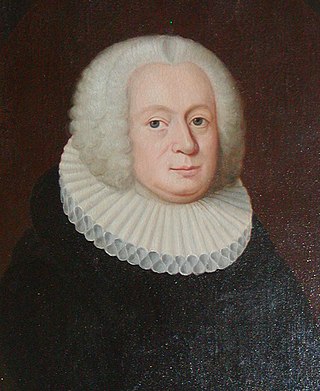
Erik Ludvigsen Pontoppidan was a Danish author, a Lutheran bishop of the Church of Norway, a historian, and an antiquarian. His Catechism of the Church of Denmark heavily influenced Danish and Norwegian religious thought and practice for roughly the next 200 years after its 1737 publication.
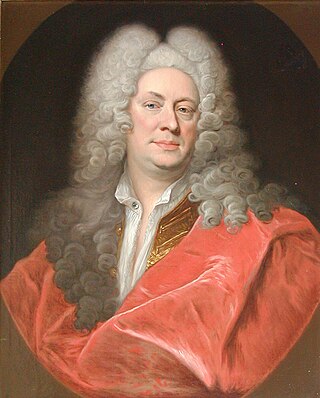
Hendrick Krock was a Danish history painter who, from 1706, was the court painter of Frederick IV as well as his successor Christian VI. Along with Benoit Le Coffre set the tone for history painting in Denmark during the 18th century-1720s, having been influenced by the Italian baroque painting he experienced during his travels. He also played a role in the eventual establishment of an Art Academy in Denmark.
Hieronimo Miani, also known as Hieronymus Miani, was an Italian history painter, who worked in Denmark as both a painter to the royal court of King Christian VI, and as a teacher.
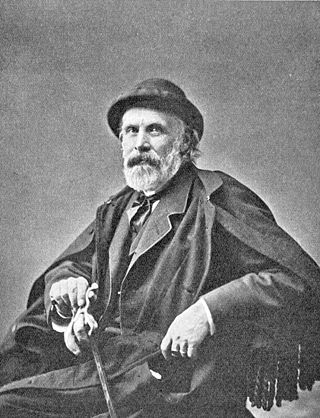
Lorenz Frølich was a Danish painter, illustrator, graphic artist and etcher.
Events from the year 1789 in art.
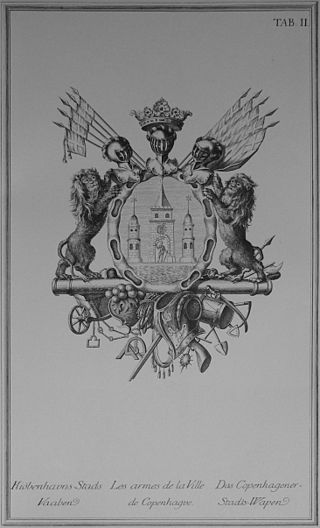
Den Danske Vitruvius is a richly illustrated 18th-century architectural work on Danish monumental buildings of the period, written by the Danish Baroque architect Lauritz de Thurah. It was commissioned by Christian VI in 1735 and published in two volumes between 1746 and 1749. The title refers to the Roman architect and engineer Vitruvius, who published De architectura in the 1st century AD, an authoritative treatise on the architecture of the time. The direct inspiration for de Thurah's Den Danske Vitruvius was Colen Campbell's Vitruvius Britannicus.
Johan Ludvig Mansa, was a German-Danish landscape gardener. The majority of his work was in transforming formal French gardens into English landscape gardens. Some remnants of his works can still be seen on the slope north of Marienlyst Castle in Helsingør as well as a few manors and palaces around Denmark.

Jean Louis Tocqué was a French painter. He specialized in portrait painting.
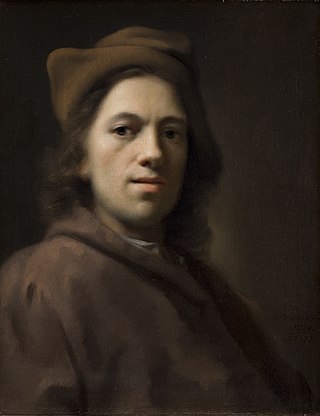
Balthasar Denner was a German painter, highly regarded as a portraitist. He painted mostly half-length and head-and-shoulders portraits and a few group portraits of families in interiors. Usually Denner concentrated on the face; clothes and paraphernalia were done by other painters or later his daughter. His chief peculiarity consisted in the fineness of his mechanical finish, which extended to depicting even the almost invisible furze of hair growing on smooth skin. He is particularly noted for his heads of old men and women.
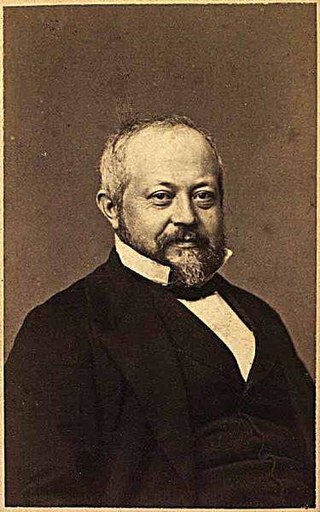
Heinrich Hansen was a Danish architectural painter and State Councillor. His son, Adolf Heinrich-Hansen, was also an architectural painter.

Magnus Berg was a Norwegian-born wood carver, painter, sculptor and non-fiction writer who settled in Denmark.

The Coronation Chair of Denmark is the chair formerly used in the coronation of the Danish monarch.
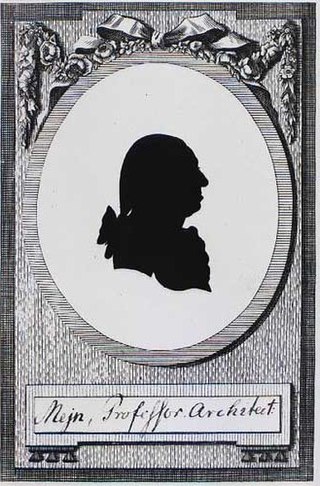
Peter Meyn was a Danish architect.
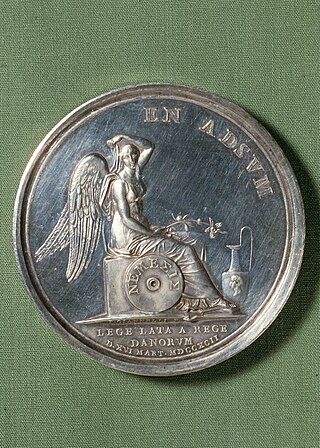
Peter Leonhard Gianelli was a Danish medallist and sculptor. His most notable works include two medels commemorating the Danish Abolition of the Slave Trade (1792) and the Battle of Copenhagen (1801), both of which were based on drawings by Nicolai Abraham Abildgaard.

Tibirke Church, originally located in the long-gone village of Tibirke, is a Church of Denmark parish church located close to Tisvildeleje, Gribskov Municipality, some 60 km (37 mi) northwest of Copenhagen, Denmark.